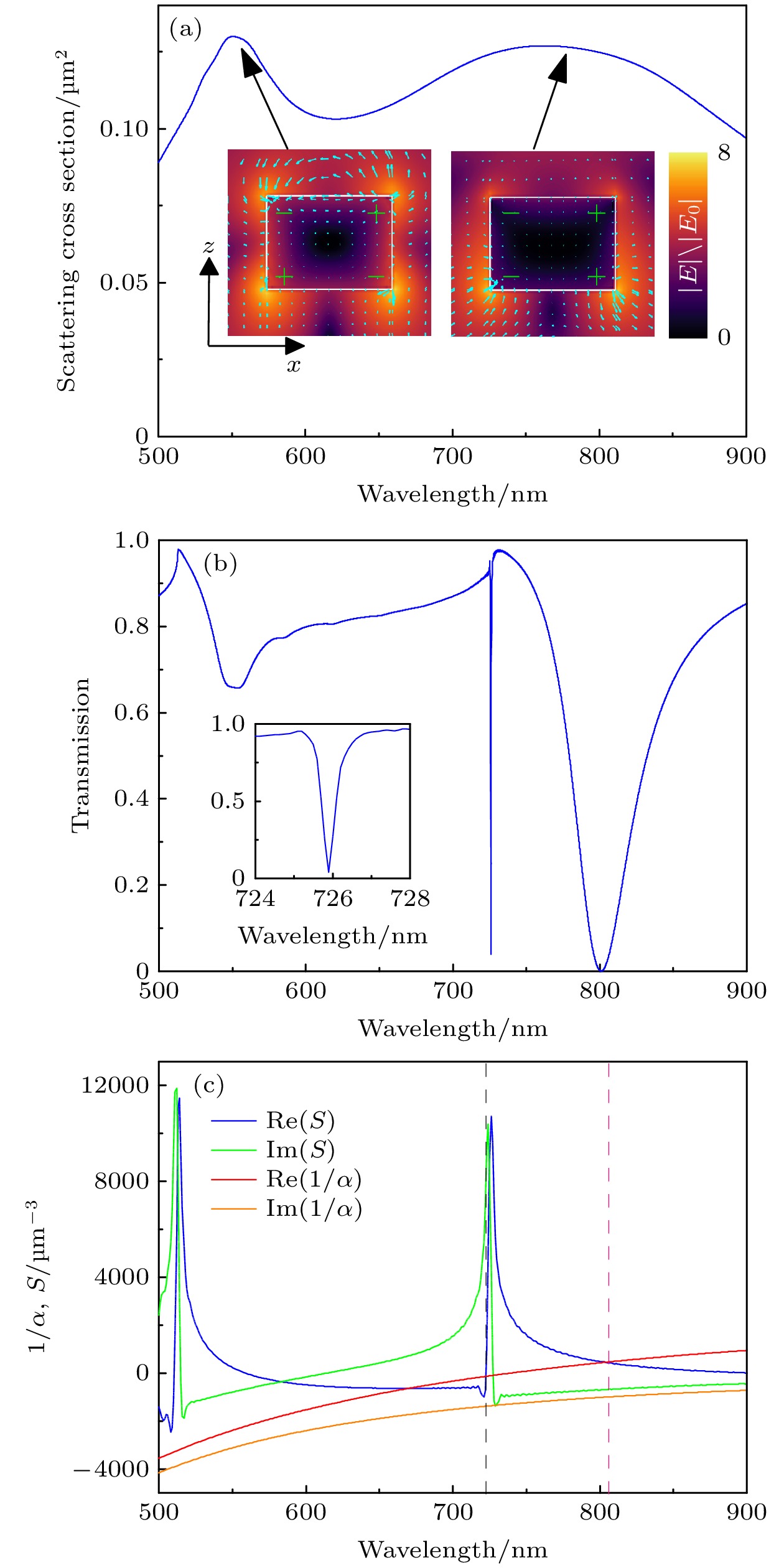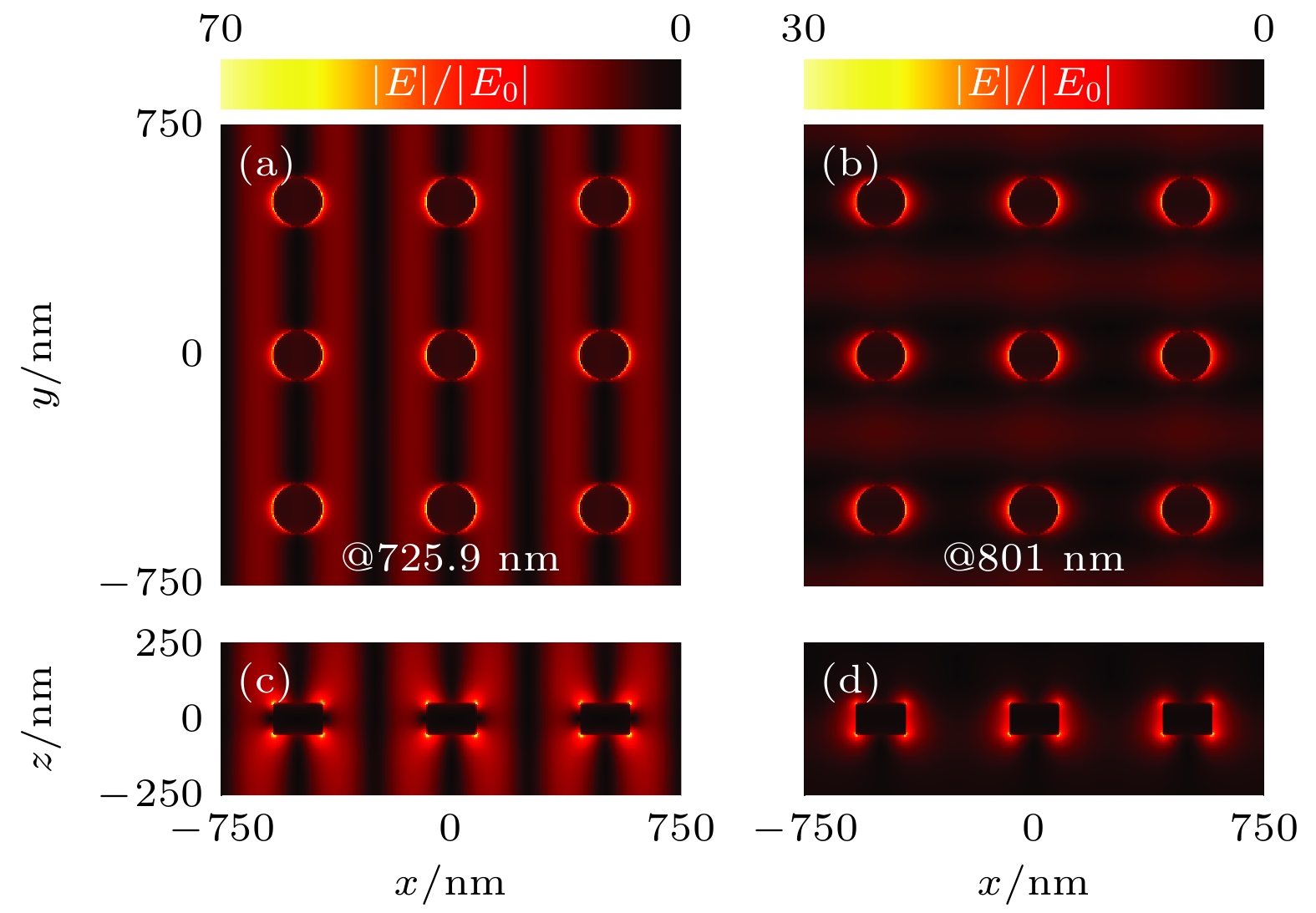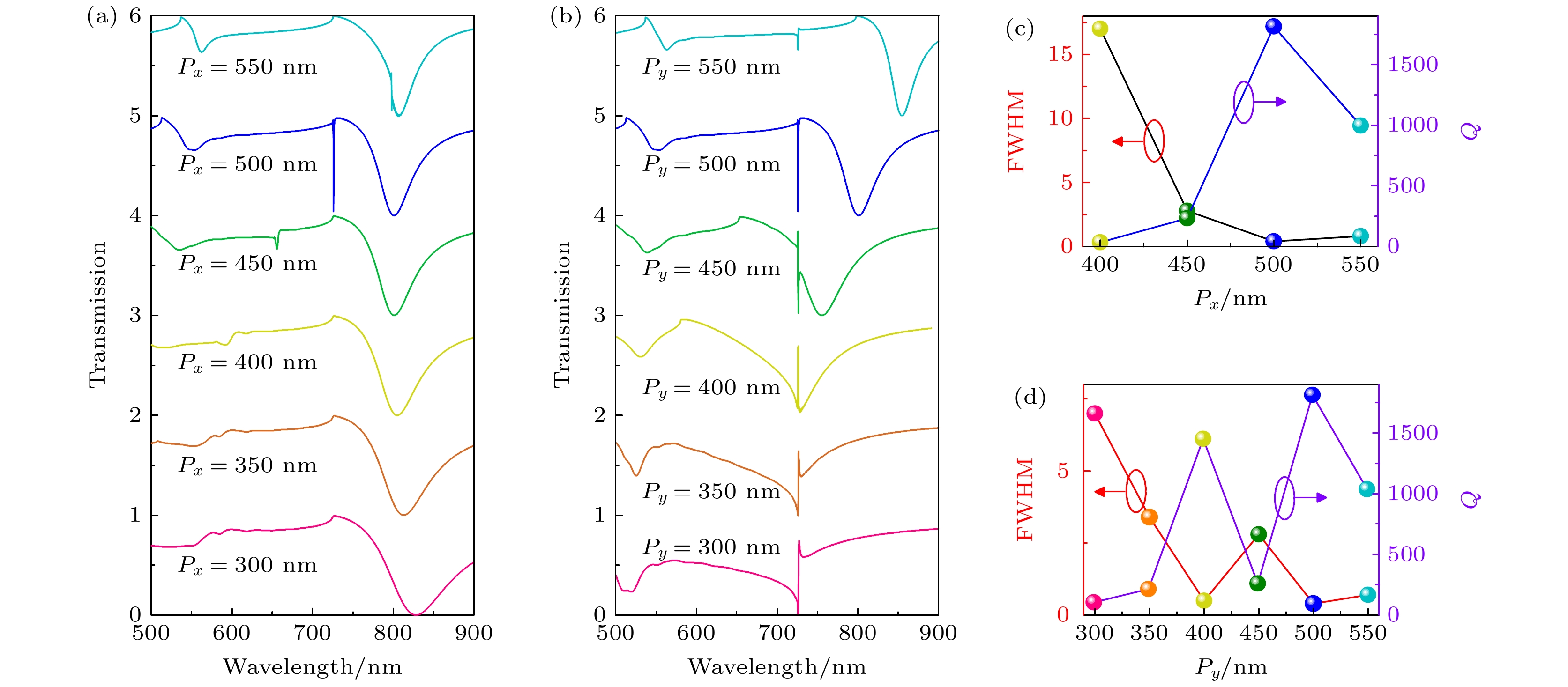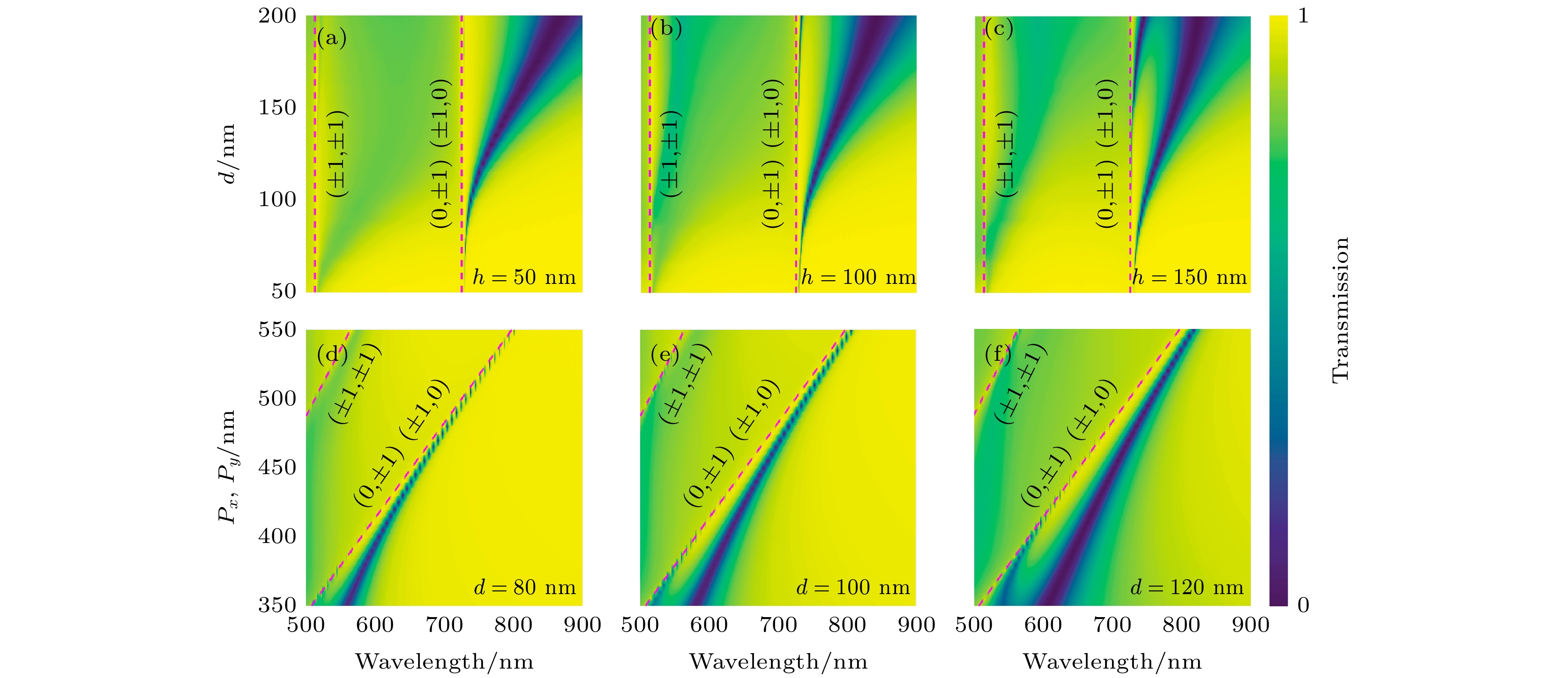-
金属纳米颗粒阵列中形成的四偶极晶格共振模式具有低辐射损耗、高品质因子的特性, 因此广泛应用于纳米激光、传感、固态照明等领域. 基于时域有限差分法在均匀环境下研究了银纳米圆柱阵列的光谱与近场特性. 研究结果表明, 在x偏振光直入射下, 通过调节阵列x方向的周期, 共振强度先增加后降低, 当两个方向上的周期相等时, 提出的阵列结构能够产生一个线宽约0.4 nm、品质因子高达1815的四偶极晶格共振模式, 这种共振模式呈现出Fano线型的透射谷; 调控y方向的周期能够实现从Fano线型的透射峰到透射谷的转变. 本文说明了粒子大小、晶格周期对四偶极晶格共振模式的重要性, 同时为银纳米颗粒在可见光波段设计高品质因子共振提供了优化策略.Periodic nanoparticle arrays with lower loss or high-quality (Q) factor resonances have made great advances in numerous applications. Such arrays can support narrow resonance modes by the hybridization of plasmonic-photonic modes, known as lattice plasmon modes (LPMs). The LPMs arise from the diffraction-induced coupling between localized surface plasmon resonances (LSPRs) of nanoparticles in symmetric or quasi-symmetric refractive index environment. To date, the great majority of researches have focused on the coupling of dipolar modes to in-plane orthogonal diffraction waves in nanoparticle arrays, resulting in dipolar lattice plasmon modes (DLPMs). However, there are few studies about quadrupolar lattice plasmon modes (QLPMs) for parallel coupling in symmetric environment, especially for high Q-factor QLPMs. In this work, we explore the sharp QLPMs of the silver nanodisk arrays by x-polarized light at normal incidence. In the first place, the scattering cross-section and near-field electric field distribution of single silver nanodisk indicate the existence of dipolar and quadrupolar LSPRs, thus, the optical responses of silver nanodisk arrays exhibit the peak-and-dip profiles of DLPMs and QLPMs at different wavelengths. Also, the electromagnetic field distributions confirm that the parallel propagating electric field introduces QLPM and results in electric field delocalization, while DLPM is existent in another way in periodic silver nanodisk arrays. Moreover, the position, linewidth and lineshape of the QLPM strongly depend on the role of lattice period. We enable these resonance modes to be selectively accessed and individually optimized by tuning lattice periods in the x- or y-direction. By changing the lattice period in the x-direction from 300 to 550 nm in steps of 50 nm, the dip of transmission intensity increases gradually, and when periods in the two directions are equal, the transmission dip exhibits a narrow-band QLPM resonance with a linewidth of 0.4 nm, corresponding quality factor is as high as Q = 1815 under the x-polarized light. In particular, by varying periods in the y-direction, the QLPM can also be manipulated in a range from an asymmetric Fano-like lineshape peak to a dip. The acquisition of these results may provide a design strategy for high-Q factor resonance in nanolaser, sensing, and nonlinear optics.
-
Keywords:
- finite difference time domain method /
- quadrupolar lattice plasmon modes /
- quality factors /
- nanoparticles
[1] Wang D Q, Bourgeois M R, Guan J, Fumani A K, Schatz G C, Odom T W 2020 ACS Photonics 7 630
 Google Scholar
Google Scholar
[2] Polavarapu L, Liz-Marzán L M 2013 Phys. Chem. Chem. Phys. 15 5288
 Google Scholar
Google Scholar
[3] Nie S M, Emory S R 1997 Science 275 1102
 Google Scholar
Google Scholar
[4] Chowdhury M H, Ray K, Gray S K, Pond J, Lacowicz J R 2009 Anal. Chem. 81 1397
 Google Scholar
Google Scholar
[5] Castellanos G W, Bai P, Gómez Rivas J 2019 J. Appl. Phys. 125 213105
 Google Scholar
Google Scholar
[6] Humphrey A D, Barnes W L 2016 J. Opt. 18 035005
 Google Scholar
Google Scholar
[7] Khlopin D, Laux F, Wardley W P, Martin J, Wurtz G A, Plain J, Bonod N, Zayats A V, Dickson W, Gérard D 2017 J. Opt. Soc. Am. B: Opt. Phys. 34 691
 Google Scholar
Google Scholar
[8] Le-Van Q, Zoethout E, Geluk E J, Ramezani M, Berghuis M, Gómez Rivas J 2019 Adv. Opt. Mater. 7 1801451
 Google Scholar
Google Scholar
[9] Humphrey A D, Barnes W L 2014 Phys. Rev. B 90 075404
 Google Scholar
Google Scholar
[10] Zundel L, May A, Manjavacas A 2021 ACS Photonics 8 360
 Google Scholar
Google Scholar
[11] Bin-Alam M S, Reshef O, Mamchur Y, Alam M Z, Carlow G, Upham J, Sullivan B T, Ménard J-M, Huttunen M J, Boyd R W, Dolgaleva K 2021 Nat. Commun. 12 947
 Google Scholar
Google Scholar
[12] Hakala T K, Antti J M, Aaro I V, Guo R, Martikainen J P, Daskalakis K S, Rekola H T, Julku A, Törmä P 2018 Nat. Phys. 14 739
 Google Scholar
Google Scholar
[13] Han A X, Dineen C, Babicheva V E, Moloney J V 2020 Nanophotonics 9 3545
 Google Scholar
Google Scholar
[14] 张萌徕, 覃赵福, 陈卓 2021 物理学报 70 054206
 Google Scholar
Google Scholar
Zhang M L, Qin Z F, Chen Z 2021 Acta Phys. Sin. 70 054206
 Google Scholar
Google Scholar
[15] Lozano G, Louwers D J, Rodríguez S R K, Murai S, Jansen O T A, Verschuuren M A, Gómez Rivas J 2013 Light-Sci. Appl. 2 e66
 Google Scholar
Google Scholar
[16] Vitrey A, Aigouy L, Prieto P, García-Martín J M, González M U 2014 Nano Lett. 14 2079
 Google Scholar
Google Scholar
[17] Wang D Q, Bourgeois M R, Lee W K, Li R, Trivedi D, Knudson M P, Wang W J, Schatz G C, Odom T W 2018 Nano Lett. 18 4549
 Google Scholar
Google Scholar
[18] Li R, Wang D Q, Guan J, Wang W J, Ao X Y, Schatz G C, Schaller R, Odom T W 2019 J. Opt. Soc. Am. B: Opt. Phys. 36 E104
 Google Scholar
Google Scholar
[19] Lin L H, Zheng Y B 2015 Nanoscale 7 12205
 Google Scholar
Google Scholar
[20] Muravitskaya A, Movsesyan A, Kostcheev S, Adam P M 2019 J. Opt. Soc. Am. B: Opt. Phys. 36 E65
 Google Scholar
Google Scholar
[21] Liu S D, Yue P, Zhang S, Wang M S, Dai H W, Chen Y Q, Nie Z Q, Cui Y X, Han J B, Duan H G 2020 Adv. Opt. Mater. 8 1901109
 Google Scholar
Google Scholar
[22] Nikitin A G 2014 Appl. Phys. Lett. 104 061107
 Google Scholar
Google Scholar
[23] Lin L H, Yi Y S 2015 Opt. Express 23 130
 Google Scholar
Google Scholar
[24] Meier M, Wokaun A, Liao P F 1985 J. Opt. Soc. Am. B: Opt. Phys. 2 931
 Google Scholar
Google Scholar
[25] Johnson P B, Christy R W 1972 Phys. Rev. B 6 4370
 Google Scholar
Google Scholar
[26] Kravets V G, Kabashin A V, Barnes W L, Grigorenko A N 2018 Chem. Rev. 118 5912
 Google Scholar
Google Scholar
[27] Teperik T V, Degiron A 2012 Phys. Rev. B 86 245425
 Google Scholar
Google Scholar
[28] Yang A, Hryn A J, Bourgeois M R, Lee W K, Hu J, Schatz G C, Odom T W 2016 Proc. Natl. Acad. Sci. U. S. A. 113 14201
 Google Scholar
Google Scholar
-
图 1 (a) 银纳米圆柱在均匀介电环境下的阵列结构示意图, 电场沿x方向的光场垂直入射到阵列表面; (b) 单个单元的结构示意图, 其中阵列在x与y方向的周期用
$ {P_x} $ 与$ {P_y} $ 表示, 圆柱高度、直径分别用h, d表示Fig. 1. (a) A schematic diagram of silver nanodisk arrays in a symmetric medium environment under x-polarized light incidence; (b) oblique view of a unit cell of the proposed array structure.
${P_{ {x}}}$ ,$ {P_y} $ , h and d represent period in x and y directions, height and diameter of silver nanodisk arrays, respectively.图 2 (a) 高度h = 100 nm, 直径d = 160 nm的单个银纳米粒子散射截面光谱; 插图为偶极与四偶极LSPRs在x-z平面对应的电场强度与方向(箭头)分布, 纳米圆柱的侧面轮廓用白色框表示, “+”与“–”符号表示正负电荷; (b) 银纳米圆柱阵列在x偏振光照射下的透射谱, 插图为QLPM的放大图; (c) 银纳米圆柱阵列极化率倒数(
$ 1/\alpha $ )与格点和(S), 黑色虚线表示瑞利异常衍射, 粉色虚线表示DLPM共振波长Fig. 2. (a) Scattering cross section for single silver nanoparticle with h = 100 nm and d = 160 nm. The inset shows the electric field intensity and direction (in arrow) distribution corresponding to the dipolar and the quadrupolar LSPR modes. The outline of the nanoparticle is represented by a white box, and the sign “+” and “–” indicate positive and negative charges; (b) the transmission spectra of DLPM and QLPM of the silver nanodisks array under the x-polarized light. Inset: zoom-in of the transmission dip for the QLPM; (c) the real part of the reciprocal polarizability (
$ 1/\alpha $ ) and the lattice sum (S) for the silver nanodisk arrays. The black and pink dashed lines represent the (0, ± 1) RAs and resonance wavelength, respectively.图 5 周期
$ {P_x} $ =$ {P_{\text{y}}} $ = 500 nm保持不变, 对于银纳米圆柱高度(a) h = 50, (b) 100 与 (c) 150 nm下直径d从50 nm变化到200 nm时阵列的透射谱. 高度h = 100 nm保持不变, 对于圆柱直径(d) d = 80, (e) 100 与(f) 120 nm下, 银纳米圆柱阵列周期P从350 nm变化到550 nm时的透射谱. 粉色虚线表示瑞利异常衍射阶次, 颜色条代表透射强度Fig. 5. Transmission spectra of silver nanodisk arrays with (a) h = 50, (b) 100, and (c) 150 nm for different diameters (from 50 to 200 nm with a 5 nm step) under the normal incidence, while
$ {P_{\text{x}}} $ =$ {P_y} $ = 500 nm is fixed. Transmission spectra of silver nanodisk arrays with (d) d = 80, (e) 100 and (f) 120 nm for different lattice periods (from 350 to 550 nm with a 5 nm step) under the normal incidence, when h = 100 nm is fixed. The pink dashed lines represent the diffraction orders, and the color bar represents the transmission intensity. -
[1] Wang D Q, Bourgeois M R, Guan J, Fumani A K, Schatz G C, Odom T W 2020 ACS Photonics 7 630
 Google Scholar
Google Scholar
[2] Polavarapu L, Liz-Marzán L M 2013 Phys. Chem. Chem. Phys. 15 5288
 Google Scholar
Google Scholar
[3] Nie S M, Emory S R 1997 Science 275 1102
 Google Scholar
Google Scholar
[4] Chowdhury M H, Ray K, Gray S K, Pond J, Lacowicz J R 2009 Anal. Chem. 81 1397
 Google Scholar
Google Scholar
[5] Castellanos G W, Bai P, Gómez Rivas J 2019 J. Appl. Phys. 125 213105
 Google Scholar
Google Scholar
[6] Humphrey A D, Barnes W L 2016 J. Opt. 18 035005
 Google Scholar
Google Scholar
[7] Khlopin D, Laux F, Wardley W P, Martin J, Wurtz G A, Plain J, Bonod N, Zayats A V, Dickson W, Gérard D 2017 J. Opt. Soc. Am. B: Opt. Phys. 34 691
 Google Scholar
Google Scholar
[8] Le-Van Q, Zoethout E, Geluk E J, Ramezani M, Berghuis M, Gómez Rivas J 2019 Adv. Opt. Mater. 7 1801451
 Google Scholar
Google Scholar
[9] Humphrey A D, Barnes W L 2014 Phys. Rev. B 90 075404
 Google Scholar
Google Scholar
[10] Zundel L, May A, Manjavacas A 2021 ACS Photonics 8 360
 Google Scholar
Google Scholar
[11] Bin-Alam M S, Reshef O, Mamchur Y, Alam M Z, Carlow G, Upham J, Sullivan B T, Ménard J-M, Huttunen M J, Boyd R W, Dolgaleva K 2021 Nat. Commun. 12 947
 Google Scholar
Google Scholar
[12] Hakala T K, Antti J M, Aaro I V, Guo R, Martikainen J P, Daskalakis K S, Rekola H T, Julku A, Törmä P 2018 Nat. Phys. 14 739
 Google Scholar
Google Scholar
[13] Han A X, Dineen C, Babicheva V E, Moloney J V 2020 Nanophotonics 9 3545
 Google Scholar
Google Scholar
[14] 张萌徕, 覃赵福, 陈卓 2021 物理学报 70 054206
 Google Scholar
Google Scholar
Zhang M L, Qin Z F, Chen Z 2021 Acta Phys. Sin. 70 054206
 Google Scholar
Google Scholar
[15] Lozano G, Louwers D J, Rodríguez S R K, Murai S, Jansen O T A, Verschuuren M A, Gómez Rivas J 2013 Light-Sci. Appl. 2 e66
 Google Scholar
Google Scholar
[16] Vitrey A, Aigouy L, Prieto P, García-Martín J M, González M U 2014 Nano Lett. 14 2079
 Google Scholar
Google Scholar
[17] Wang D Q, Bourgeois M R, Lee W K, Li R, Trivedi D, Knudson M P, Wang W J, Schatz G C, Odom T W 2018 Nano Lett. 18 4549
 Google Scholar
Google Scholar
[18] Li R, Wang D Q, Guan J, Wang W J, Ao X Y, Schatz G C, Schaller R, Odom T W 2019 J. Opt. Soc. Am. B: Opt. Phys. 36 E104
 Google Scholar
Google Scholar
[19] Lin L H, Zheng Y B 2015 Nanoscale 7 12205
 Google Scholar
Google Scholar
[20] Muravitskaya A, Movsesyan A, Kostcheev S, Adam P M 2019 J. Opt. Soc. Am. B: Opt. Phys. 36 E65
 Google Scholar
Google Scholar
[21] Liu S D, Yue P, Zhang S, Wang M S, Dai H W, Chen Y Q, Nie Z Q, Cui Y X, Han J B, Duan H G 2020 Adv. Opt. Mater. 8 1901109
 Google Scholar
Google Scholar
[22] Nikitin A G 2014 Appl. Phys. Lett. 104 061107
 Google Scholar
Google Scholar
[23] Lin L H, Yi Y S 2015 Opt. Express 23 130
 Google Scholar
Google Scholar
[24] Meier M, Wokaun A, Liao P F 1985 J. Opt. Soc. Am. B: Opt. Phys. 2 931
 Google Scholar
Google Scholar
[25] Johnson P B, Christy R W 1972 Phys. Rev. B 6 4370
 Google Scholar
Google Scholar
[26] Kravets V G, Kabashin A V, Barnes W L, Grigorenko A N 2018 Chem. Rev. 118 5912
 Google Scholar
Google Scholar
[27] Teperik T V, Degiron A 2012 Phys. Rev. B 86 245425
 Google Scholar
Google Scholar
[28] Yang A, Hryn A J, Bourgeois M R, Lee W K, Hu J, Schatz G C, Odom T W 2016 Proc. Natl. Acad. Sci. U. S. A. 113 14201
 Google Scholar
Google Scholar
计量
- 文章访问数: 7184
- PDF下载量: 116
- 被引次数: 0













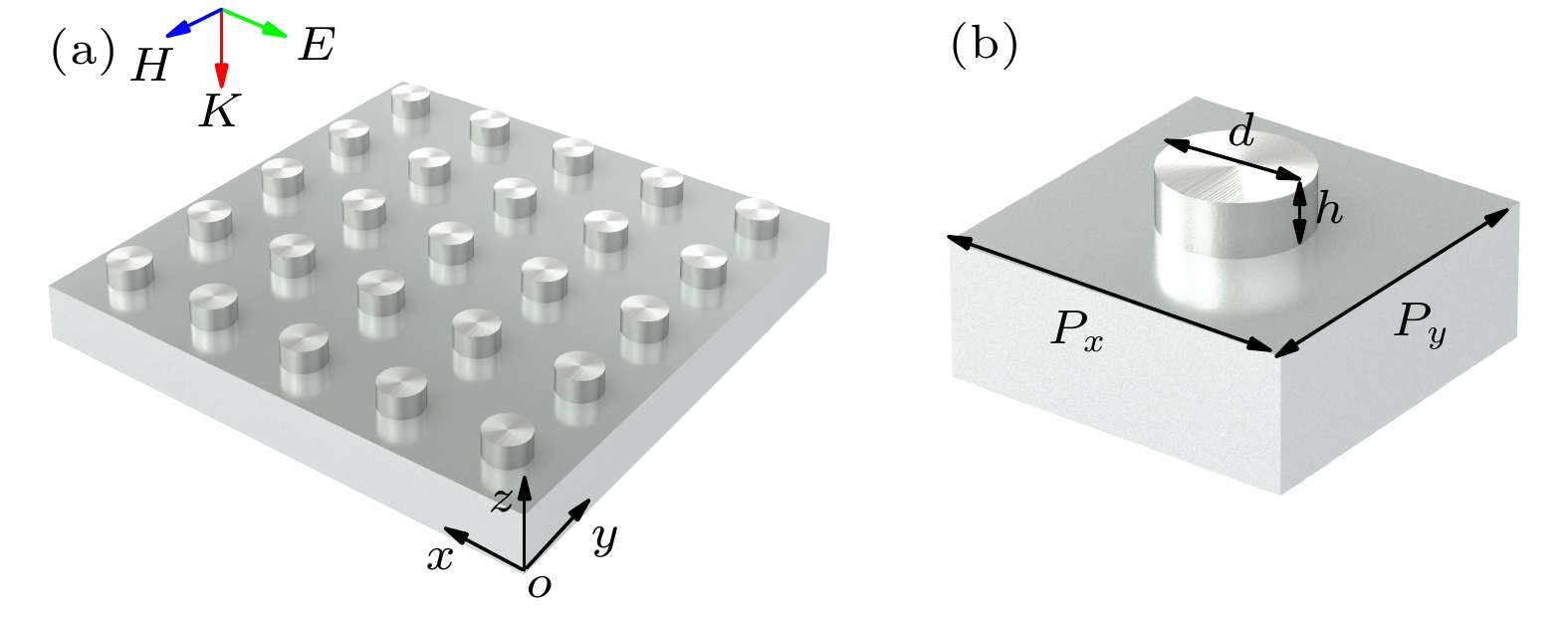




 下载:
下载:
